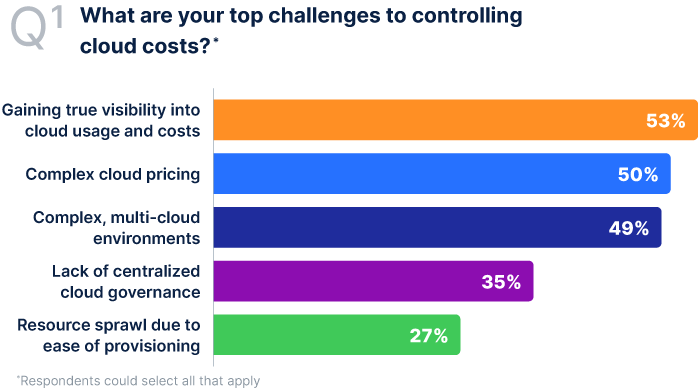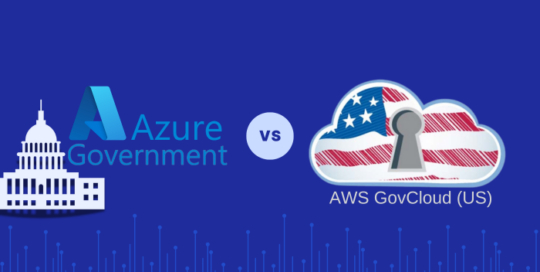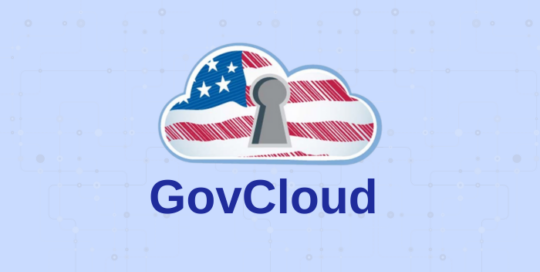Cloud migration efforts continue to grow today as organizations move into a post-pandemic work environment. According to McKinsey & Company, by 2024, most enterprises aspire to have $8 out of every $10 for IT hosting go toward the cloud. In a survey by Morgan Stanley, CIOs say cloud computing will see the highest rate of IT spending growth in 2022.
Cloud cost complexity is growing
The rapid shift to the cloud combined with the complexity of navigating cloud usage and costs has companies struggling to control cloud spend and reduce waste. The problem is compounded by a souring economy, uncertainty of a recession, and the need for companies to cut costs and shore up revenue growth numbers.
Some of the challenging aspects of managing cloud infrastructure include monitoring costs, optimizing resource use, and forecasting future spend. The very nature of cloud computing – and indeed, a reason that companies flock to it – is that compute capabilities can rapidly adjust to accommodate current business demands. Cloud storage capacity and databases fluctuate as well, contributing to the complexity of cloud providers’ billing processes.
Cloud cost visibility crisis
Companies are facing an urgent cloud cost visibility crisis with real implications for the bottom line. As cloud spending becomes one of the most expensive resources for a growing number of organizations, IT, Finance and C-Suite leaders are prioritizing strategies and tools to optimize spend, reduce cloud waste and centralize cloud cost management.
The Anodot 2022 State of Cloud Cost survey, conducted over a two-week span in June and July 2022, helps us understand how organizations of varying sizes and vertical industries across the United States are coping with the challenges of gaining control over cloud costs.
We found the following insights to be most interesting:
- Nearly 50% of IT executives say it’s difficult to get cloud costs under control.
- Respondents say gaining visibility into cloud usage and costs is the top challenge for controlling spend and reducing waste.
- 88% of those surveyed say optimizing and reducing spend on existing cloud resources is extremely or very important.
- Despite these challenges, 60% say migrating more workloads to the cloud is their top cloud initiative in the coming year, making it more important than ever to leverage next generation cloud cost management solutions to understand costs, optimize spend, and reduce waste.
SMBs and enterprises face similar challenges
Anodot surveyed 131 high level information technology executives who have direct line of sight into how much their organizations spend on cloud computing each year. Approximately half the respondents represent SMBs and the other half come from enterprise organizations. As for annual cloud spend, about half of the companies are under a million dollars while the rest spend over a million, with 15% spending more than $5 million each year.
Even with this wide range of company size and cloud budgets among the respondents, many agree they face the same challenges: difficulty gaining true visibility into cloud costs, accelerating migration of workloads to the cloud, expectations to spend up to 30% more in 2023, excessive time to notice spikes in cloud costs when they occur, and complex cloud pricing models. These issues seem to be universal regardless of company size.
Cloud visibility is the biggest challenge to controlling costs
The majority (53%) of survey respondents say their biggest challenge to controlling costs is in gaining true visibility into their cloud usage and associated costs. This is followed closely by the complexity of cloud pricing (50%) and the use of complex, multi-cloud environments (49%).
In fact, these three issues are closely related. It’s hard to gain visibility into every aspect of cloud usage with an associated cost when the total environment in use is quite complex or even stretched across multiple providers’ platforms. For companies with a multi-cloud strategy, managing and optimizing costs across providers is nearly impossible due to proprietary and dissimilar pricing models.
This challenge of gaining visibility to control cloud costs has given rise to “FinOps,” defined as “an evolving cloud financial management discipline and cultural practice that enables organizations to get maximum business value by helping engineering, finance, technology, and business teams to collaborate on data-driven spending decisions.”
However, even companies that have invested in FinOps still feel they lack the granular visibility needed for optimized cost management. Consider that cloud spend often occurs in siloes spread among different internal teams and with multiple third-party cloud providers, causing a communication and budgeting gap that requires the use of multiple tools to resolve.
Moreover, cloud resource payment schemes often use a complex hierarchy and tagging system to monitor and track cost drivers via dashboards and reports. These systems are often inconsistent within customer accounts and across cloud service providers, making it difficult to reconcile costs.
Bring your cloud costs under control with Anodot
Organizations continue to move workloads to the cloud to support their digital transformations and to gain the opportunities for innovation that only the cloud can provide. Even as they do so, half of IT leaders say it’s difficult to get cloud costs under control.
Cloud pricing models are complex and hard to understand. It’s a challenge to gain true visibility into cloud usage and costs, especially as companies invest more heavily in containers and multi-cloud environments. This dearth of visibility makes cost forecasting more difficult. As a result, monthly invoices can sometimes deliver surprises over unexpected costs.
Anodot’s cloud cost management solution provides complete, end-to-end visibility into an organization’s entire cloud infrastructure and related billing costs. By monitoring cloud metrics together with revenue and business metrics, Anodot enables cloud teams to understand the true cost, utilization, and performance of their cloud services.
With continuous monitoring and deep visibility, businesses gain the power to align FinOps, DevOps, and Finance teams and reduce their total cloud bill.
- Eliminate waste – Anodot’s easy-to-action savings recommendations enable your DevOps team to easily implement spending and service changes that can drive significant savings.
- Cost Allocation – See cost causation and allocate spend by service, business unit, team, and app with deep visibility across AWS, Azure, GCP, and pod-level Kubernetes.
- Enable FinOps – Avoid bill shock with near real-time alerts and insightful, machine-learning driven forecasting.
Anodot also provides granular insights into Kubernetes that no other cloud optimization platform offers. Businesses can easily track spending and usage across clusters with detailed reports and dashboards. Anodot for Cloud Costs’ powerful algorithms and multi-dimensional filters enable a deep dive into performance and identify under-utilization at the node level.
Anodot’s artificial intelligence-powered forecasting leverages deep learning to automatically optimize cloud cost forecasts, enabling businesses to anticipate changing conditions and usage and get a better read on related costs.
Smart teams use Anodot to avoid daily, weekly, and monthly surprises in their cloud bill. Contact us to learn what autonomous cloud cost monitoring can do for you.
Start optimizing your cloud costs today!
Connect with one of our cloud cost management specialists to learn how Anodot can help your organization control costs, optimize resources and reduce cloud waste.






